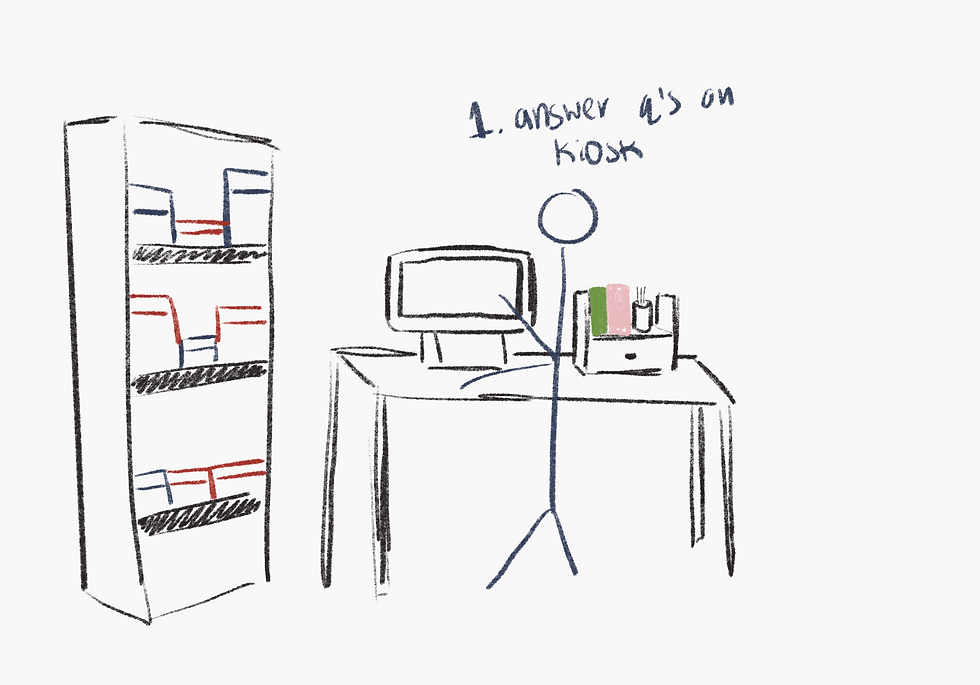Concept
Throughout the experience, I wanted to heavily emphasize feelings of reflection as well as nostalgia. My goal was for those who interact with the piece to reflect on themselves, as well as their relationships with the people around them. Emphasizing the process of reflection through writing a postcard blends together two deeply personal experiences and ties together the stories of so many individuals. Furthermore, since many people do not have the time to reflect on themselves and their relationships very often, I want to provide a space away from the bustle of everyday life for them to do so. Aesthetically, I want the postcards, stamps, kiosk, etc to all have a nostalgic and vintage feel. As a result, I find my piece to be interesting from an aesthetic standpoint because it mixes technology with a process that is traditionally analog. Nowadays, technology is so present in everyday life that it’s used as the main form of communication. On the other hand, postcards and other mail used to be main forms of communication in the past. Sending postcards while on vacation used to be a popular way to share what someone was up to, but with the rise of social media and messaging, people just send a text or post some pictures. In addition, the way that social media is designed accentuates the speed of life, while postcards create a sense of slowness and leisure. Thus by combining technology and postcards together, it creates an in-between space that allows for reflection while still incorporating the technology that we have grown so used to using. Specifically, the technological aspects serve to create an analog experience for the viewer, with the postcards that they write on as well as the scrapbooks and postage stamps that are included.




Instruction-based art
-
Instruction based art as a creative concept (where the devising of instructions is seen as an artistic act in itself) can be traced by to Marcel Duchamp
-
He aimed to challenge existing conventions and perceptions of art and art ownership
-
-
When an artist devises a set of instructions to make art (for someone else to complete), where lies the art? Is the art the idea or the instructions themselves. Or is the art the physical art of the participant making/doing/following the instructions? Where is the value (the art completed or the instructions)?
-
Following instructions becomes an active part of making the work
-
Concept and potential for a work to be made are just as important as the object itself
-
Instead of showing an example of the work realized as an object, only present the text instructions
-
Makes the idea itself the work of art, not necessarily connected to an object or physical matter
-
Instructions transfer ideas directly to the viewer
-
-
Viewers can engage directly with an artist
-
Instruction based art allows art to exist outside of the boundaries of a museum
-
“I like the idea of doing something that stimulates people’s minds and, of course, they can use their own creativity to think about it.”
-
“You had, for instance, a work like Waterdrop Painting (1961), in which, every few seconds, water would drop onto a disk of canvas lying on the floor. In Painting to Be Stepped On (1960) there was a piece of fabric placed on the ground which people could actually walk on. There was a way to perform the painting. During that show, you could also take instructions with you. The works were a manifestation of the instructions, but you were also free to perform or to realize an idea by Yoko Ono at home after the fact.”
Mail art
Mail art draws its roots back to 1943 with Ray Johnson, an American artist who used the postal system as a way to connect people in a large cycle of artistic exchange. A key source of inspiration for Johnson was that he found “mailed correspondence interesting because of the limits it puts on the usual back and forth interaction and negotiation that comprises communication between individuals”. This point made by Johnson draws an interesting parallel with technology today, again with the “back and forth interaction and negotiation that comprises communication between individuals”. One of the reasons why I wanted to utilize postcards in my project was to highlight the more deliberate and slow process of sending and receiving mail.
Related Works

Ray Johnson, Untitled (Please Add To & Return To Ray Johnson), n.d., Mail art photocopy
Frank Warren, PostSecret, 2004


Yoko Ono, Painting to be Stepped On, 1960/1961